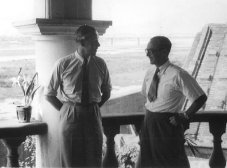Basil William Sholto Mackenzie. 2nd Baron Amulree.
Born: 25 July 1900. Died: 15 December 1983.
KBE (1977) MRCS LRCP (1925) MB BChir Cantab (1927)
MRCP (1928) MA MD (1936) FRCP (1946)
Sholto Mackenzie was the son of a lawyer who became Lord Amulree as a member of Ramsay Macdonald’s first Labour Government. Sholto was himself Liberal Whip in the Lords from 1955 to 1977, but did not play a leading role in politics, rather following his uncle Sir James Mackenzie into medicine. He turned to pathology on qualification and worked mainly in that field at UCH and the Royal Northern Hospital until he joined the medical staff of the Ministry of Health in 1936. After three years working on the provision of cancer treatment facilities, on which he wrote a published report, he was deflected by the chances of war to the Ministry’s concern with the care of the “chronic sick” in public assistance institutions. He was also made the Ministry’s medical specialist on the safety of water supplies; but the possibility of better care for the elderly caught his attention and held it for the rest of his career.
Marjory Warren had done her pioneer work at the North Middlesex Hospital in the late 1930s. Trevor Howell, Lionel Cosin, E.W. Brook, Joseph Sheldon, and Oscar Olbrich had all shown the possibilities, and Sholto had been their trusted ally in the Ministry. For someone who was a physician rather than an administrator the transition to a clinical post in the new specialty was to be expected, but the actual opportunity was important. UCH, having acquired Saint Pancras Hospital and a large number of static beds for chronically ill older people from their district, could not continue in the blinkered fashion of most teaching hospitals of the time. They had the sense to offer Sholto the opportunity of organising a geriatric service. He accepted the challenge and created something quite new for a London teaching hospital; only Oxford among the teaching hospitals acted similarly, with Lionel Cosin’s unit at Cowley Road.
Sholto’s first departure was to carry the service into the local community. He saw that the rehabilitation of the elderly had to be attuned to what their home situations would allow them to do. The problems were – and are – more social than technically medical. Narrow statutory demarcations of health, or welfare authorities’ boundaries of responsibility, are equally unsuitable. The question is not merely “What disease affects this patient?” but “What help does this person need and who can give it?” The answer is always multiple, and Sholto and senior registrar disciples demonstrated that. It was the theme of his book, Adding Life to Years. He did not waste time debating the doctrinal justification of his specialty; he just showed that it worked. It was not by chance that the first Chair of geriatrics in London was set up in his old unit, nor that the first professor had been his first senior registrar.
Sholto will not be remembered, as his uncle is, for outstanding clinical or research activity. He saw the best way to cope with one of the major problems of developed societies today - care of the elderly – and he made it work. The succeeding generation should not forget that he had to climb his mountain before they could even locate theirs. Nor was his influence narrowly medical. He was President of the Society for the Study of Medical Ethics, the London County Division of the BRCS, the Association of Occupational Therapists, the British Geriatrics Society and, most remarkable of all, the Association of Welfare Officers. He was also Chairman of the council of the London Medical Group. One of his less known, but more important activities, was the chairmanship of the Attendance Allowance Board from its inception, opening an important new contribution to the care of the handicapped. The KBE awarded to him in 1977 recognised a lifetime of public service.
Sholto was a friendly, but modest, almost diffident man, yet he was tenacious and transparently without personal ambition. He had a severe stammer, and learned to control it, and he met his other problems with the same resolution. He was unmarried but had a wide circle of friends. There may have been other more flamboyant figures in the fields he cultivated but none of them raised a better crop.
Courtesy of the RCP Monk’s Roll
